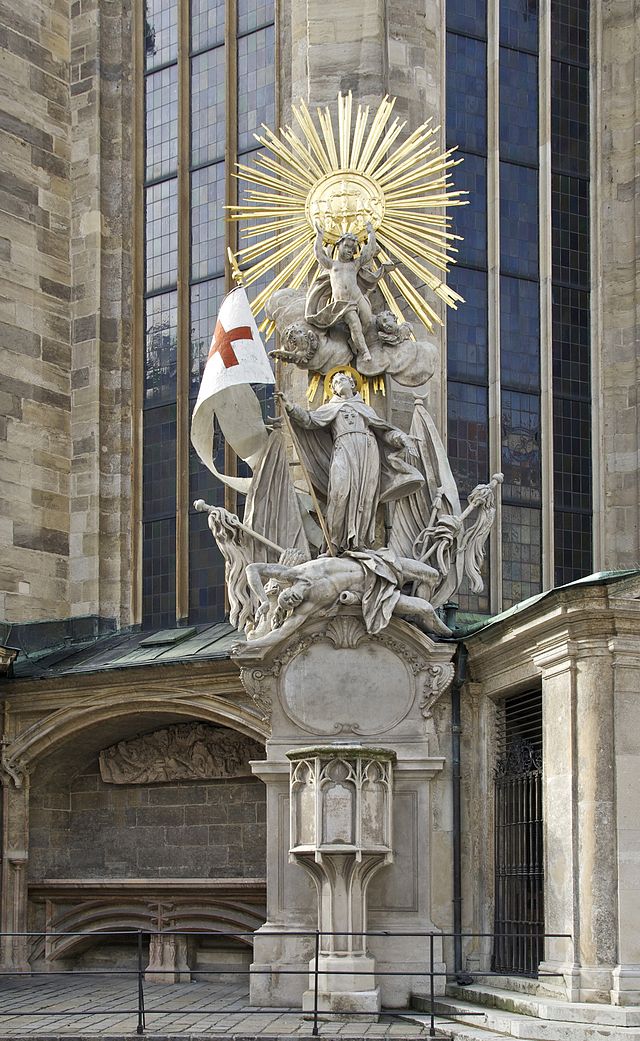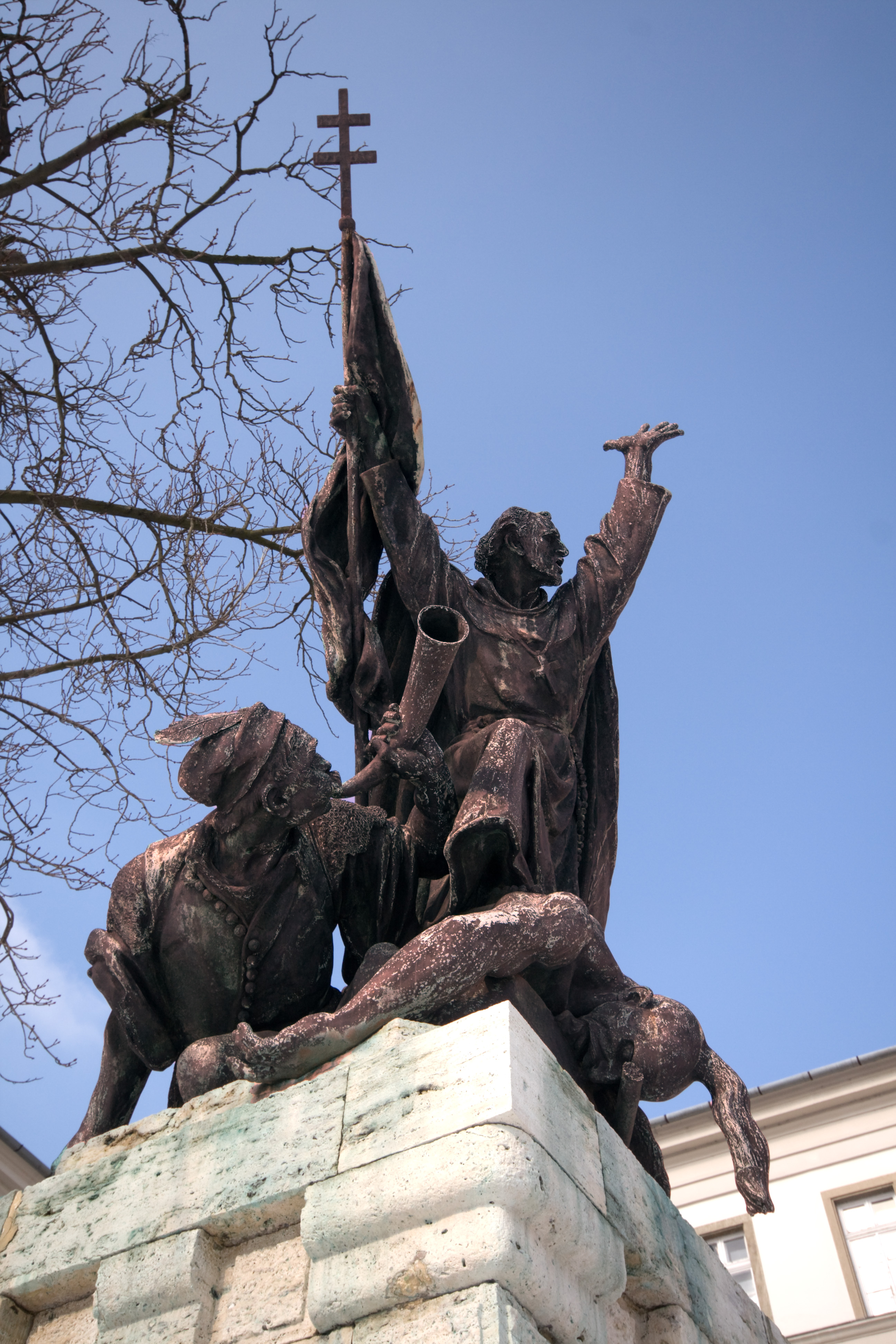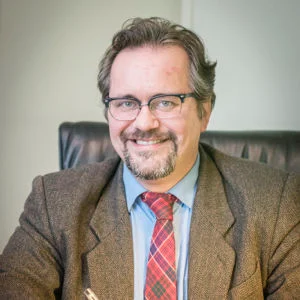
-St John of Capistrano’s pulpit, St Stephen’s Cathedral, Vienna, Austria
On a business trip, I was fortunate to visit Mission San Juan Capistrano, of swallows fame, in California. A married saint, sort of.
It has been said the Christian saints are the world’s greatest optimists. Not blind to the existence and consequences of evil, they base their confidence on the power of Christ’s redemption. The power of conversion through Christ extends not only to sinful people but also to calamitous events.
Famous as a preacher, theologian, and inquisitor, he earned himself the nickname ‘the Soldier Saint’ when in 1456 at age 70 he led a crusade against the invading Ottoman Empire at the siege of Belgrade with the Hungarian military commander John Hunyadi.
Imagine being born in the 14th century. One-third of the population and nearly 40 percent of the clergy were wiped out by the bubonic plague. The Western Schism split the Church with two or three claimants to the Holy See at one time. England and France were at war. The city-states of Italy were constantly in conflict. No wonder that gloom dominated the spirit of the culture and the times.
John Capistrano was born in 1386, the son of a German knight, his father died when John was still young. His education, however, was thorough. His talents and success were great. The young man studied law at the University of Perugia, and worked as a lawyer in Naples. He became a highly successful judge and magistrate in Perugia.
In 1412, when he was 26 he was made governor of Perugia by King Ladislaus of Naples, and was a great political reformer of that city. War broke out between Perugia and the House of Malatesta from Rimini in 1416. John tried to broker a peace, but when his opponents ignored a truce and he was betrayed, John was imprisoned after a battle against the Malatestas.
During his imprisonment, John resolved to change his way of life completely. He had married just before the war, but the marriage was never consummated, and with his bride’s permission, it was annulled. He joined the Franciscans at Perugia on 4 October 1416. At the age of 30 he entered the Franciscan novitiate and was ordained a priest four years later.
His preaching attracted great throngs at a time of religious apathy and confusion. He and 12 Franciscan brethren were received in the countries of central Europe as angels of God. They were instrumental in reviving a dying faith and devotion.
The Franciscan Order itself was in turmoil over the interpretation and observance of the Rule of St. Francis – the Fratricelli. Through John’s tireless efforts and his expertise in law, the heretical Fraticelli were suppressed.
John helped bring about a reunion with the Greek and Armenian Churches, unfortunately only a brief arrangement. As the Eastern Church began to realize the Turks would triumph, it sought reconciliation with Rome – its only possible hope. It is conjectured by scholars that the genesis of the Renaissance was the flight of Eastern Christian scholars, artists, and thinkers to the West occasioned by the final collapse of the Eastern Byzantine Empire, direct descendant of the ancient Empire of Rome itself. Two thousand years – not a bad run, actually.
When the Turks captured Constantinople in 1453, Mehmed II threatened Vienna and Rome. John was commissioned to preach a crusade for the defense of Europe. Gaining little response in Bavaria and Austria, he decided to concentrate his efforts in Hungary. He led the army to Belgrade. Under the great General John Hunyadi, they gained an overwhelming victory, and the siege of Belgrade was lifted. St John of Capistrano led his own contingent of soldiers into battle. Worn out by his superhuman efforts, Capistrano was an easy prey to the infection bred by the refuse of battle. He died October 23, 1456 of bubonic plague.
John Hofer, a biographer of John Capistrano, recalls a Brussels organization named after the saint. Seeking to solve life problems in a fully Christian spirit, its motto was: “Initiative, Organization, Activity.” These three words characterized John’s life. He was not one to sit around, ever. His deep Christian optimism drove him to battle problems at all levels with the confidence engendered by a deep faith in Christ.
On the saint’s tomb in the Austrian town of Villach, the governor had this message inscribed: “This tomb holds John, by birth of Capistrano, a man worthy of all praise, defender and promoter of the faith, guardian of the Church, zealous protector of his Order, an ornament to all the world, lover of truth and religious justice, mirror of life, surest guide in doctrine; praised by countless tongues, he reigns blessed in heaven.” That is a fitting epitaph for a real and successful optimist.

-statue of János Kapisztran (Saint John Capistrano) in Kapisztran Tér, Budapest, Hungary
“Those who are called to the table of the Lord must glow with the brightness that comes from the good example of a praiseworthy and blameless life. They must completely remove from their lives the filth and uncleanness of vice. Their upright lives must make them like the salt of the earth for themselves and for the rest of mankind. The brightness of their wisdom must make them like the light of the world that brings light to others. They must learn from their eminent teacher, Jesus Christ, what he declared not only to his apostles and disciples, but also to all the priests and clerics who were to succeed them, when he said, “You are the salt of the earth. But what if salt goes flat? How can you restore its flavor? Then it is good for nothing but to be thrown out and trampled underfoot.” Jesus also said: “You are the light of the world.” Now a light does not illumine itself, but instead it diffuses its rays and shines all around upon everything that comes into its view. So it must be with the glowing lives of upright and holy clerics. By the brightness of their holiness they must bring light and serenity to all who gaze upon them. They have been placed here to care for others. Their own lives should be an example to others, showing how they must live in the house of the Lord. – from the treatise Mirror of the Clergy by Saint John of Capistrano
“Remove from your lives the filth and uncleanness of vice. Your upright lives must make you the salt of the earth for yourselves and for the rest of humankind.”
-St. John of Capistrano

-by Sean Fitzpatrick
“The meeting was not going very well. Having assembled a group of military leaders in the Hungarian city of Györ, Fr. John Capistrano—nearly seventy years old and standing bravely in his shabby monastic garb, as though it were shining armor—made a fiery call for a crusade against the invading Ottoman legions of Mehmed II.
“It is the will of almighty God that the Turks be driven from Europe,” the wizened friar insisted. “For those who follow me in this crusade, and their families, I will obtain a plenary indulgence. Who will march with me and my army?”
That “army” was a ragtag company of farmers, seminarians, peasants, students, and landowners whom John had assembled and who awaited his spirited and spiritual leadership, armed with pitchforks, scythes, clubs, and other clumsy weapons and tools. Numbering 8,000, they were not an impressive force. But John was undaunted and determined to make an impression—if not on these warlords, then certainly on Mehmed II.
The silence that overtook the room did not cow him, either, as he stared down the generals and diplomats gathered there who knew not what to say at such a proposal. Even the bold Hungarian warrior of Wallachian blood, John Hunyadi, felt the tension. He and his fellows were not convinced and shifted uncomfortably as John Capistrano awaited their response.
The only man who seemed cool under the heated call to arms was one who some doubted was a man at all. Another of Wallachian descent, he sat still as a statue, eyes smoldering beneath his princely headgear and his tremendous moustache concealing any sign from his mouth. Vlad Dracul, called the Impaler, was listening, recognizing something in this wiry, hollow-cheeked old priest that matched the fanaticism and ferocity of the Turks.
Dracul’s eyes met Hunyadi’s. Thus began the unlikely alliance among a saint, a soldier, and a vampire.
Born in 1386 in the kingdom of Naples, John of the town of Capistrano gained a far-flung reputation as a lawyer turned priest turned reformer who was from the beginning a hard-hitting, hard-to-get-along-with man of God.
After the fall of Constantinople in 1453, Pope Callixtus III charged him—due to his potent personality, no doubt—to muster a force to arrest the Turkish invasion of Eastern Europe. So, after years of preaching and laboring for the faithful and the Franciscans with Bernardine of Siena, John of Capistrano then turned soldier-priest and amassed what troops he could from the streets and villages of Hungary, determined to gain more official assistance in breaking the sultan’s siege of Belgrade.
John’s meeting with the Hungarian military heads in Györ seemed to fall on deaf ears, so he marched with his motley crew of crusaders toward the besieged fortress of Belgrade. But his exhortation had not been futile. Not only did he win the admiration of the savage Wallachian prince, Vlad Dracul, but he also stirred the martial politician John Hunyadi.
John Hunyadi formed a relief force for the determined John Capistrano and mounted a fleet of 200 ships on the Danube. Throwing his gauntlet into the impending campaign, Vlad Dracul agreed to hold the Transylvanian passes against Turkish reinforcements with his mercenaries and protect the eastern defenses of Belgrade.
In the summer of 1456, John Capistrano met John Hunyadi and Vlad Dracul on the groaning walls of Belgrade. There they sealed their alliance for the cause of Christ. They had mustered a significant militia, including war vessels, siege guns, and cannons. And when battle broke, so did the siege of Belgrade. The blusterous old priest, frail as he was, charged into the thick of the fighting with his men, bearing nothing but a crucifix to protect him.
With the valiant aid of Hunyadi and the strategic support of Dracul, John Capistrano emerged as a central figure in repelling the Ottoman stranglehold around Belgrade, which threatened not only Hungary, but also the Christian West. Together, they burst through the ring of Turkish land forces while the fleet on the Danube cleaved the seemingly unbreakable Turkish armada that had blocked passage to the city.
In desperation, Mehmed II joined the combat and was wounded in the thigh. As he was borne away, the Turkish army succeeded in penetrating the city—but, with the protruding bastions around the rampart turrets allowing for a deadly crossfire from above on those battering the walls below, the janissaries were finally routed at the fortress by the combined forces of John Capistrano, John Hunyadi, and Vlad Dracul.
Over 24,000 Turks fell in the fighting. The beautiful blue Danube ran red with blood as the bells pealed over Belgrade. Te Deum rang out, and when the news reached Rome, Pope Callixtus named the great day of victory as the feast of the Transfiguration.
Though John Capistrano survived the Siege of Belgrade, he did not survive the Bubonic Plague, which took his life only weeks afterward. He died on October 23, 1456 and would be canonized as the patron saint of Hungary.
St. John Capistrano has remained on the offensive for Hungary even from heaven. In fact, exactly 500 years later to the day, in 1956, Hungary chose John’s feast day to rebel against the Hungarian People’s Republic, imposed by the Soviet Union, and were victorious.
The story of John Capistrano’s league with the noble General Hunyadi and the savage Count Dracul of vampiric legend is one of those moments in history that are almost too fantastic for most fairy tales. What happened at Belgrade was a miracle—more of a miracle of concord than combat—and it is such miracles that will save Christian culture.
God can make the most dissimilar of men brothers by his inscrutable ways, which often involve circumstances that seem as though they’re from out of a dream world—such as a battle led by a saint, a soldier, and a vampire.”
(Dracula voice) Goood Eevening, 🙂
Matthew
